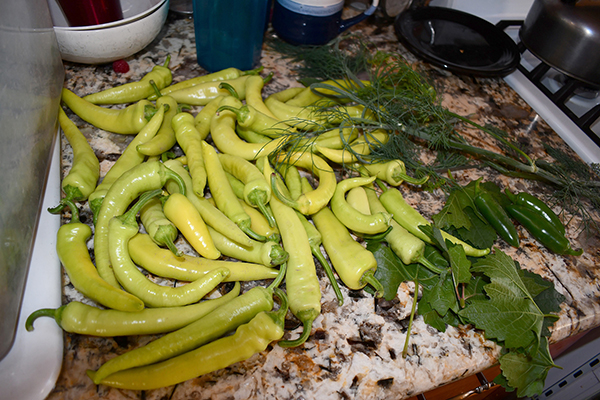 The yellow banana peppers are coming on now in the garden and here is what was picked today on our kitchen counter. We grew these last year and really enjoyed their sweet flavor in salads and snack trays. Yum. Gonna try a new flavor adventure on these guys by trying a new recipe of pickling on them. I also did a search on Google and stumbled on this wonderful site, “Insanely Good” with 10 recipes for banana peppers. Now, I am going to have to try all of them, cause they look so good.
The yellow banana peppers are coming on now in the garden and here is what was picked today on our kitchen counter. We grew these last year and really enjoyed their sweet flavor in salads and snack trays. Yum. Gonna try a new flavor adventure on these guys by trying a new recipe of pickling on them. I also did a search on Google and stumbled on this wonderful site, “Insanely Good” with 10 recipes for banana peppers. Now, I am going to have to try all of them, cause they look so good.
 The starts looked like this, just after their transplant in the middle of May 2023. You can tell that we loved their flavor last year so we saved a lot of seed and did many starts for both our garden and the North County Food Pantry garden.
The starts looked like this, just after their transplant in the middle of May 2023. You can tell that we loved their flavor last year so we saved a lot of seed and did many starts for both our garden and the North County Food Pantry garden. They are producing very well in the middle of July, about 60 days after their initial transplant.
They are producing very well in the middle of July, about 60 days after their initial transplant.
 Happy light green peppers that continue growing into longer and yellower fellows on the vine. They are a bright yellow when they are ready to pick. We will have an abundance of these tasty little guys this year. We can eat them fresh, dehydrate and freeze them, or pickle them.
Happy light green peppers that continue growing into longer and yellower fellows on the vine. They are a bright yellow when they are ready to pick. We will have an abundance of these tasty little guys this year. We can eat them fresh, dehydrate and freeze them, or pickle them.
 There should be quite a
There should be quite a  Clearing the Jungle
Clearing the Jungle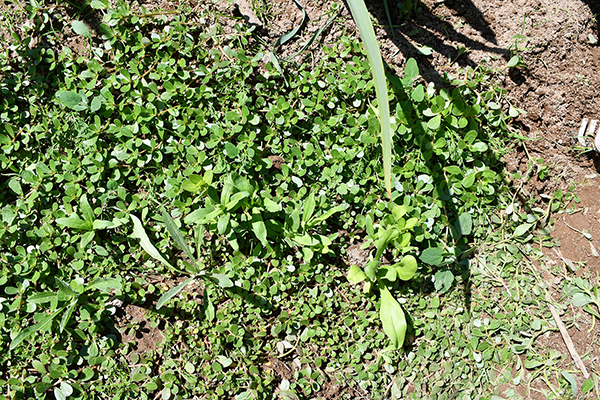 A kind of search and rescue mission ensues to discover where the zinnias, marigolds, and other flower seeds are located among the ground cover weeds. Can you see the different shaped leaves in a row? It is hard to see, isn’t it? I start with the for-sure weeds and work my way around until I can discover where the row is.
A kind of search and rescue mission ensues to discover where the zinnias, marigolds, and other flower seeds are located among the ground cover weeds. Can you see the different shaped leaves in a row? It is hard to see, isn’t it? I start with the for-sure weeds and work my way around until I can discover where the row is.
 Here it is all weeded and transplanted. They sure wilt and look horrible for a little while, but I always follow my grandma’s advice. Immediately, give any transplant a real good drink and they will be fine. She is totally right!
Here it is all weeded and transplanted. They sure wilt and look horrible for a little while, but I always follow my grandma’s advice. Immediately, give any transplant a real good drink and they will be fine. She is totally right!
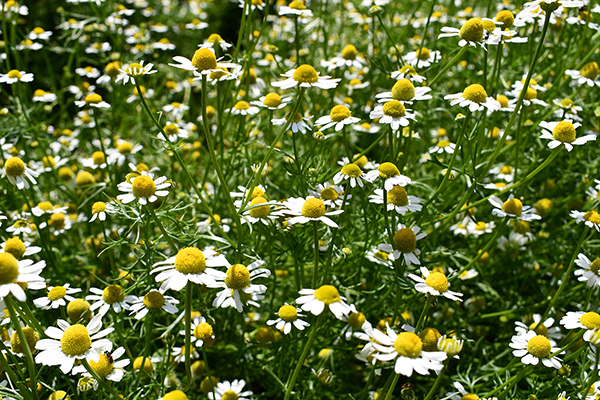
 Cosmos is a self-seeding flower that I have learned to fully embrace in our garden design. I pick the perfect place to put an area of plants that naturally re-seed themselves each spring, my workload is decreased by the self-seeder because I don’t have to plant them every earl spring. . I do have to manually weed this area but, I have to weed during the life cycle of any crop we plant.
Cosmos is a self-seeding flower that I have learned to fully embrace in our garden design. I pick the perfect place to put an area of plants that naturally re-seed themselves each spring, my workload is decreased by the self-seeder because I don’t have to plant them every earl spring. . I do have to manually weed this area but, I have to weed during the life cycle of any crop we plant.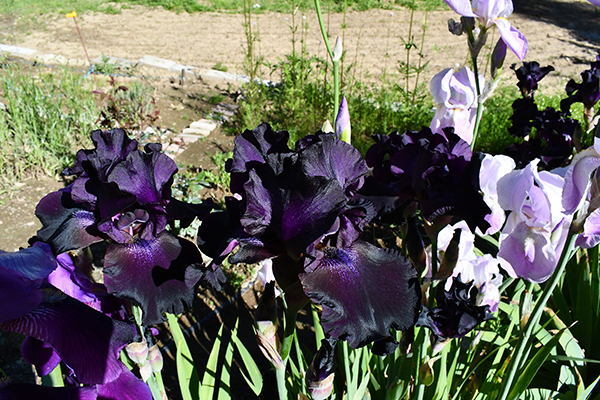 Iris is a colorful and fragrant part of early spring for us. They just don’t seem to last long enough each year.
Iris is a colorful and fragrant part of early spring for us. They just don’t seem to last long enough each year. Daisies are a pleasure to see. We love the way that the Perennials keep coming back every year.
Daisies are a pleasure to see. We love the way that the Perennials keep coming back every year.
 Both the California (yellow) and Oriental poppies are blooming in a colorful array to be picked and dried to make teas and tinctures. The yellow California poppy blossoms are safe for non-narcotic teas and tinctures.
Both the California (yellow) and Oriental poppies are blooming in a colorful array to be picked and dried to make teas and tinctures. The yellow California poppy blossoms are safe for non-narcotic teas and tinctures.


 Poppies are another container of flowers that are picked in the early morning to make tea and tinctures with. You can see the wide range of colors that they bloom in.
Poppies are another container of flowers that are picked in the early morning to make tea and tinctures with. You can see the wide range of colors that they bloom in.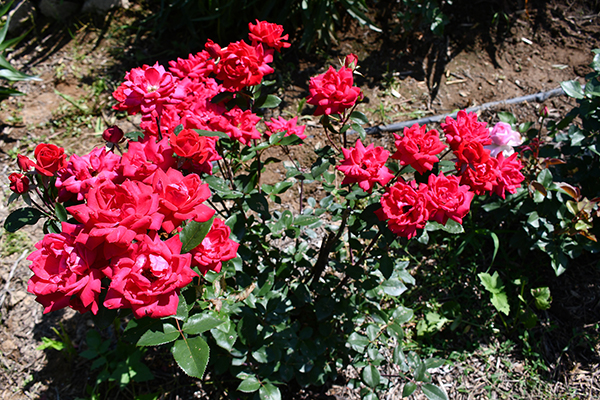 The roses are blooming and I collect their blossoms for use in making beauty creams.
The roses are blooming and I collect their blossoms for use in making beauty creams.
 Let’s not forget the hollyhocks who have tall and graceful figures in the garden.
Let’s not forget the hollyhocks who have tall and graceful figures in the garden. Grape leaves are very artistic and beautiful.
Grape leaves are very artistic and beautiful.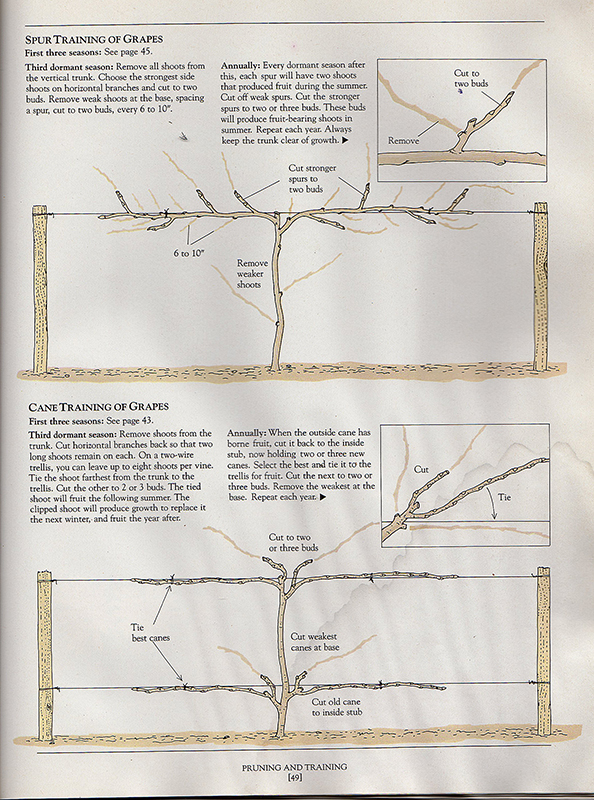 The vines are looking very happy this year and are growing quickly. However, I did notice some weird bumps on one of our grape plants while training its vines around their supports this year.
The vines are looking very happy this year and are growing quickly. However, I did notice some weird bumps on one of our grape plants while training its vines around their supports this year.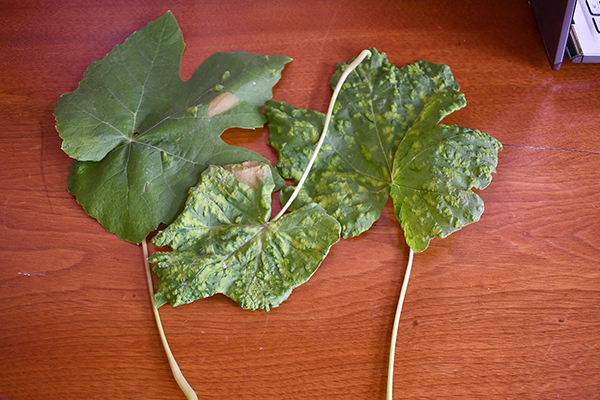 On the top of the leaf, weird raised blisters show up that resembles the kind you get on your hands when you forget to use gloves.
On the top of the leaf, weird raised blisters show up that resembles the kind you get on your hands when you forget to use gloves.  But, on the back was a white powdery substance so, of course, I had to Google it.
But, on the back was a white powdery substance so, of course, I had to Google it. 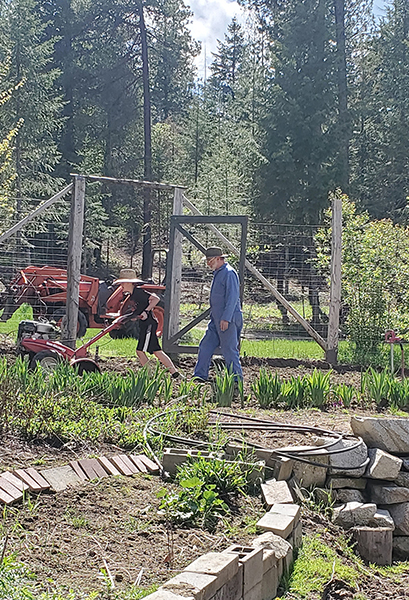 Tie ’em Up! Once the plant starts are established and begin to crawl on the ground we tie them up on fencing, to protect them from wind and it makes it easier to pick later on. Then, Mr. Wind won’t be able to lay them all down if he decides to visit.
Tie ’em Up! Once the plant starts are established and begin to crawl on the ground we tie them up on fencing, to protect them from wind and it makes it easier to pick later on. Then, Mr. Wind won’t be able to lay them all down if he decides to visit.
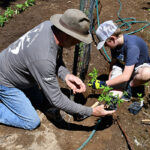


 This is a 60-foot row of tomatoes with lots of varieties, and sizes but only two cherry tomato plants closest to the gate. Where I stood to take the picture. Why, are there only two cherry tomatoes? We don’t have enough time to harvest those teeny tiny cherry tomatoes.
This is a 60-foot row of tomatoes with lots of varieties, and sizes but only two cherry tomato plants closest to the gate. Where I stood to take the picture. Why, are there only two cherry tomatoes? We don’t have enough time to harvest those teeny tiny cherry tomatoes.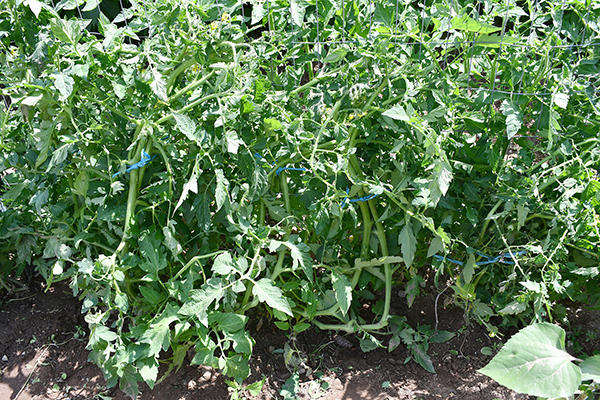 A larger volume of tomato products is what is important to us. Tied-up tomato plants look like this when done. We grow as many tomatoes as possible. This year we are delighted with how early our tomatoes began to make fruit. We changed
A larger volume of tomato products is what is important to us. Tied-up tomato plants look like this when done. We grow as many tomatoes as possible. This year we are delighted with how early our tomatoes began to make fruit. We changed